#cleaner open in st. Johns
Explore tagged Tumblr posts
Text
How To Find A Professional Cleaner Open in ST. John, London?
Residents and businesses alike can now sigh relief as a professional laundry cleaner open in st. Johns, London its doors to serve the community. This new addition brings convenience and cleanliness to a bustling area where the demands of daily life can often leave laundry chores overlooked. Read More: https://medium.com/@ukdropletuk/how-to-find-a-professional-cleaner-open-in-st-john-london-cca3fc69a950

#cleaner open in st. Johns#London#local laundry service southfields London#dry clean price In Balham#\
0 notes
Text
Depression Master Post
I AM NOT A DOCTOR OR THERAPIST, JUST SAYING WHAT WORKS FOR ME
Tips that work for me:
♡Utilize your audio notes apps on your phone as an 'audio diary', talk to yourself like it's a podcast, interview, imaginary bestie etc
♡warm wet rag, toner (I use a bottle type and a spray type), moisturizer, Vaseline for a 'lazy' skincare routine. You can also use rose water to cleanse your face. This takes literally five minutes
♡modified stretches/workouts are your best friend, it's actually very easy to do stretches without getting outta bed or even moving your blanket!!
♡open up your blinds!!!!!
♡ensures and similar brands w/ extra protein for days you absolutely can't get out of bed
♡can't shower? No problem. You can get bathing cloths at any pharmacy otc (you can purchase with an HSA card as well!) Just add water to the pack no soap or rinsing needed
♡any food is better than no food!!!
♡90 minute rice + tuna packs are good 5 minute meals w/ some substance. You can add any add ins you want(I add fried egg and avocado)
♡download the finch app!! It's super cute and like a self care tamagotchi
♡allow yourself the time to rest
♡have a self love/feel good Playlist ready
♡rewatch your fave childhood show/movie. Anything that's been longer than 5 years since you've seen it works best imo
♡pedialyte AND water to keep hydrated, add a pinch of pink salt to the water
♡mix water, rubbing alcohol and essential oils to make an air freshner spray for bedding and clothing
♡if you're not on any medications, combine l-theanine and st John's wort supplements for mood health (can also add St John's wort, damiana, lavender and mint/catnip to a tea or smoke blend)
♡pure tart cherry juice before bed to help you sleep
♡download the I Am app and repeat the affirmations you see out loud thrice
♡can't brush your teeth? Get a water flosser and add a bit of mouthwash & peroxide to the reservoir to kill bacteria and remove stuck food
♡use pink or brown noise as your background for sleeping, you can find these on youtube
♡download MindDoc & Gratitude if you have the spoons to have prompts and questions to answer about your mood
♡digital coloring books!!! I use infinite painer and sketchbook on my Samsung tablet
♡if you scroll any app, pick the one you see the most positive or nontoxic feed (lemon8 and tumblr for me), this way your consumption is potentially bettering your life
♡charge your phone and other devices in a separate room/a few feet away from your bed to reduce scrolling and help promote getting out of bed to turn off alarms etc
♡daily shower spray cleaner, helps keep your tub clean. I spray after I get out
♡use Groupon to schedule yourself a moodboosting self care activity for the month (massage, tanning, filler, facial)
♡eat with a tray in bed
♡spray your fave body spray before bed
Hope these tips help someone!!! Add your own in the tags or reblog ♡
Happy House Spousing ♡♡♡♡
#black housewife#black women in femininity#homemaker#bunni boo babblz#cooking#high maintenance#skincare#mental health#good advice#self isolation#keyewed
82 notes
·
View notes
Text
https://x.com/GRE8TBLACKSHARK/status/1701210980087136399?s=20
The Blue family, Sacramento
Les Robinson had to leave a family cookout to compose himself. A cousin told him to look up an ancestor on his phone — Daniel Blue. Robinson had never heard of him, but a search revealed the longtime pastor in the Sacramento area, who was integral to the region’s Black community. Robinson learned that his great-great-grandfather was brought to Sacramento in 1849 as an enslaved man from Kentucky by John Daugherty, the son of his enslaver.
Blue, 53 at the time, worked as a gold miner and discovered enough gold to buy his freedom and become an entrepreneur, opening a dry cleaners and starting a church in his home and later a stand-alone structure. That church — St. Andrews AME Church — was founded in 1850, and it remains the West Coast’s oldest continuous African Methodist Episcopal congregation. Blue also started a school for Black, Latino, Asian American and Native American children.
And he bought property. Lots of it — 60 acres, according to Robinson, including nine blocks in Sacramento, California’s capital, documents show.
On that property today, Robinson said, stands the California Railroad Museum, the Amtrak Station, Sacramento RailYard, the courthouse and the Sacramento County jail.

“I’ve been told that it was taken because the railroad needed that land to complete the transcontinental connection,” Robinson said. “So he basically was booted out.”
And burned out, as intimidation by whites who did not welcome freed Blacks turned violent. Part of the school was burned down and rebuilt before eventually it closed years later. Blue’s house was burned in 1869. There was a failed attempt to burn down the church, too, Robinson said.
Mitchell said the seizing of property — by citizens, law enforcement or the government — comes with an additional injustice beyond stunting generational wealth: It destroys culture and history.
“Whether you’re talking about Harlem or southwest Georgia, there’s often an erasure of important culture and history,” Mitchell said.
Much of what Robinson and others in his family have discovered is documented in newspaper articles and other periodicals, which makes it frustrating for Robinson that he cannot locate deeds or ownership documentation. They have not yet presented their findings to state or local officials yet, preferring to do more research and hear what the reparations task force has to say about seized land. But they are clear about what happened.
“It was obviously taken,” Robinson said. “He was a smart man. He wouldn’t give away 60-plus acres of land.” Robinson is working on a book about his ancestor that sums up what having the land returned to him and his family would mean. Yes, he wants the land for its financial value, but also for its sentimental value. Robinson, who founded a church in 1999, said the revelations about his ancestor resonate in a tangible way. Looking back and seeing what his ancestor accomplished, “I see parallels in our life — even not having ever known him,” he said. “When I found him, I met him — and we have the same spirit. I am doing what he would want me to do.”
The Burgess family, Coloma, California
It was “exhausting” for Jon Burgess when he learned that an ancestor had been the hangman in the 1800s in Coloma, a small community about 55 miles northeast of Sacramento, where his family lineage traces.
“That’s not something you want to see, and it floored me for two days,” Burgess said.

Using eminent domain, the city seized much of the 420 acres, Burgess said. Much of the land he wants to reclaim is Marshall Gold Discovery State Historic Park in Coloma.
Burgess has testified before the California reparations task force, posted short videos on Instagram about his family findings to educate followers and connected with Gov. Gavin Newsom about the subject. “I’m just trying to get people to empathize with the fact that we had an inheritance that was supposed to remain in our family for years per those deeds. And yet it was stripped away,” he said.
Burgess possesses the deed to the land, documentation he believes that when it is properly reviewed will stand up in court, particularly because there is no record of his ancestor’s selling the land, he said.
“If we didn’t have the deed, it would just be another story,” said Burgess, a firefighter. “But we do. And the deeds can certainly tell a very different story.”
What’s next for reparations
The story for all these families is unfinished. They hope their gathered documentation will yield a result similar to that of Bruce’s Beach in Southern California, where Los Angeles County seized land in Manhattan Beach purchased in 1912 by a Black couple, Charles and Willa Bruce. White residents led a petition to have their resort for Black people condemned in 1927 and turned into a park. It was returned to the Bruce family last year. The family sold it back to the county for $20 million.
The cases are not parallel to that of Bruce’s Beach, but it elicits hope for these descendants, especially as California considers reparations in such an aggressive manner.
Burgess’ case has been acknowledged by the California task force as similarly valid to that of Bruce’s Beach, and may be included in its final report and list of recommendations, which will be issued to the Legislature at the end of June.
“Land and property are things that my pioneer ancestors did not sell or take for granted, because they knew the value, coming from slave plantations’ making others wealthy for generations — all behind land,” Burgess said. “Generational wealth means my family and descendants would have the same if not more than the Bogle family, Veercamp family, Gallagher family, Del Monte family and a host of others who came here with nothing prior to 1870 and were left to prosper — but also allowed equal protection by the laws.”
#California's earliest Black settlers bought land only for it to be stolen. Their descendants want it back.#Reparations#california#Freedmen#Black Settlers in the west#stolen land#freedmen land#generational wealth
14 notes
·
View notes
Text
Beer Events 9.25
Events
Pacific Ocean discovered (1513)
1st American newspaper published (1690)
Brayton Weatherbee patented a Machine for Picking and Separating Hops (1894)
William Helmer patented a Design for a Drinking Glass (1906)
Joseph Strunce patented a Beer Pipe Cleaner (1906)
Senator Morris Sheppard was so convinced that Prohibition would be permanent that in a speech today he said "there is as much chance of repealing the 18th Amendment as there is for a hummingbird to fly to the planet Mars with the Washington Monument tied to its tail. (1930)
John Schilling patented a Crown Cap Puller (1934)
American Can Co. trademarked a flat-top beer can called "keglined" (1934)
Myron Hood patented a Gas Mixing Device for Draught Beer Dispensing (1951)
Owens Illinois patented a Composite Container Article (1973)
Summit Brewing delivered their 1st keg (St. Paul, Minnesota; 1986)
Young’s Ram Brewery closed (England; 2006)
James Muth patented a Keg Stacking Device (2008)
Rehrig Pacific patented a Beer Keg Valve (2013)
Breweries Opened
Boulder Beer Co. (Colorado; 1979)
Leavenworth Brewery (Washington; 1992)
North Peak Brewing (Michigan; 1997)
Kishiwada Brewery (Japan; 1999)
Faction Brewing (California; 2013)
0 notes
Text

𝐂𝐋𝐄𝐀𝐍𝐂𝐑𝐒 // independent rp blog home to lucretia lucky larue. thirty1. professional cleaner for all the messes your muses want to make disappear. former saboteur. MAIN VERSES & AU VERSES – crime, dc, marvel, supernatural, john wick, general city / town, star wars, spy, resident evil, open to more. multi verse, multi ship, open to canon & oc’s. 21+ only (mun & muse). open starters. memes.
penned by patches. 25. she/her. temp rules under cut & bio under construction.
TEMP RULES
21+ going forward, mun and muse please! it’s a comfort level thing, and i’d just prefer writing with 21+.
banned topics: inc*st/stepc*st, ab*se, nonc*n/dubc*n, petplay/ageplay. thank you but no. also no phobes of any kind here.
lucky is open to shipping with anyone 25+, but will thread with anyone 21+! this is a multi ship blog to keep everything sorted out, and i’m a ship wh*re tbh, so don’t be afraid to ask.
there may be triggering and mature topics on this blog due to the verses various verses i write lucky in. i’ll try to tag things, but i apologise in advance if i forget! mun ≠ muse, and i do not agree with everything my muse does.
please reblog anything that does not pertain to our thread or pairing from the source. it’s never fun to feel as though someone merely follows you to use you as a resource blog.
medium to low activity <3 i’m currently going back to college so sporadic replies and a chaotic sleep schedule is my thing.
if you read these, thank you so much! i look forward to writing with you. feel free to send in a meme, reply to an open or message to plot. i promise i don’t bite! <3
0 notes
Link
Check out this listing I just added to my Poshmark closet: St. John Metallic Florentine Knit Bolero Jacket.
0 notes
Link
Check out this listing I just found on Poshmark: St. John Made in Italy Black Logo and Patent Leather Pet Carrier.
0 notes
Text
I wrote a whole bunch (under the cut) and then I actually pulled out the text, so here’s the second, cleaner draft.
Personally, I think he definitely is not trying to make a jump for her 20k pounds, not even as a way to donate that money to God’s works in order to claim a better place in heaven. First of all, I don’t think he entertains the idea of marrying her and bringing her on his mission until she displays this disregard for material gain (and also because she vehemently removes herself from the pursuit of marriage, which I think to him means he wouldn’t be stealing her from a marital life if she comes on his mission.) Second, he says
you cannot form a notion of the importance twenty thousand pounds would give you; of the place it would enable you to take in society; of the prospects it would open to you (ch35)
He cares about status, and below the cut I talk more about how his piety is really just a status race for him to get an ever higher place in heaven. But here he isn’t thinking about the hierarchy of heaven, for Jane or himself; he’s thinking about ‘society’ in the here and now.
When she says she wants family more than money, he very clearly suggests these 20 thousand pounds would allow her to marry well, have children, and build a family that way. It’s exactly the life St John could have with Miss Oliver but he gives up because it goes against his ambitions.
Even when he proposes to her later, I don’t think he would ever have given her children; not while on missionary work; not when it’s so dangerous and he basically expects to die out there. So the fact he suggests marriage here, to me, signals he has no designs on the money. Besides, he’d only be cheating his own sisters. If he had twenty thousand pounds all to himself, I’m sure he would have provided for them as a duty anyway.
St John says he sees the “justice” in splitting their uncles money, but “it is contrary to custom.” Jane cares more about justice (and fraternity) than custom and maybe we’re being shown that St John accepts custom more easily than fighting for justice. But custom could also mean that it goes against the legalese of the will or general inheritance laws at the time. Jane even says that she has to go to court and that her “task was a very hard one” just to undergo the legal battle to distribute the legacy the way she wants. She can’t just write a check. It’s hugely subversive what she does.
Mostly I don’t think he’s trying to dissuade her but he wants to know she is being serious and fully informed before he expects anything. She’s pretty emotional (I mean she just learned they were all her cousins and she’s understandably euphoric) and her meaning isn’t even clear at first. Would you tell your sisters to quit their jobs and travel home the same night someone said “I’ll give you a fortune” or would you wait for your benefactor to be sure and for all the kinks to be ironed out? Plus, he accepts Jane as his sister right then and there. It’s kind of stunted and rationalized, but it’s also the most sincere and disinterested affection I think he ever shows. He doesn’t argue any more about her inheritance following the scene.
I have always thought his surprise and push back belies that he would not have done the same in her shoes. However, technically, Jane writes that the Rivers must “have been innately conscious that in my place they would have done precisely what I wished to do.” Maybe she's being an unreliable narrator there, or maybe I’m just speaking over the text.
I took it as one of the strongest demonstrations of how mercenary he actually is, save for God. Not for himself as her husband in this life, but the hereafter. He doesn’t understand natural generosity like Jane’s that springs from the soul. If he wasn’t as devout (and he clearly thinks Jane’s devotion is wanting), he wouldn’t behave the way Jane does and he tells on himself.
It’s sort of like when religious people ask atheists what’s stopping them from stealing and killing and you wonder, “Is god’s wrath the only thing stopping you?? Is that secretly what you want to do?”
He’s plenty generous, but only in God’s name. He’s plenty temperate, but only because he expects God’s bigger, better bounty in the afterlife. He admits his avarice: “my ambition is unlimited; my desire to rise higher, to do more than others, insatiable.” He’s playing a long game within the patriarchal hierarchy of Christianity hoping he will essentially win the bigger pay day in Heaven and be exulted more than the plebs with a higher position in heaven. I mean he’s already a ‘saint.’ And he already uses his faith to domineer over his family. Jane venerates him but she also says that he is over-powering and intimidating. He doesn’t understand true altruism that isn’t sourced from the power play of punishment/reward in Heaven.
Jane Eyre is constantly bucking against the paradox of heavenly retribution met with God’s unending grace and mercy. I find St. John very similar to Mr. Brocklehurst, except St. John was just smarter. In my view, it boils down to Brönte exploring how the patriarchy has bastardized Christianity, particularly through an afterlife ranking order. Even Dante questioned this paradox couple hundred years earlier.
In St. John’s case he may think he’s clear of fearing hell, but he's still 'climbing the ladder' of heaven, needing to rise higher. And he literally hastens his death because this life is the grind and death is the promotion. The book ends on that! I mean it’s kinda sick. He can’t just honor God by living a good life and being happy with the woman he loves, like Jane does with you, OP. [”Must I relinquish] the hope of heaven for the fear of hell?...It is dearer than the blood in my veins. It is what I have to look forward to and to live for.” ( ರロರ) And you could argue that St. John is a bit sacrilegious to disrespect his own life like that. Maybe that’s just me. Jane doesn’t see it like that and St John clearly feels secure in the promise of his heavenly rewards.
The Brönte sisters probably talked a lot about the issues of reward and retribution in the Bible, because Anne wrote about how suffering in an eternity of hell didn’t seem right and couldn’t be right and that despite what the church said it didn’t fit into her beliefs. (Just looked it up, it was called Universal Salvation. Copy of her letter here.) It’s a huge theme regarding Huntington’s death in Tenant of Wildfell Hall.
Did St. John attempt to dissuade Jane from sharing her inheritance with her cousins out of moral righteousness, or was he hoping to marry her and claim all twenty thousand pounds for himself (for God, yeah sure)?
#i can't engage like a normal person i have to write a whole as paper#Jane Eyre#st john#sorry if there are typos#Bronte
132 notes
·
View notes
Photo
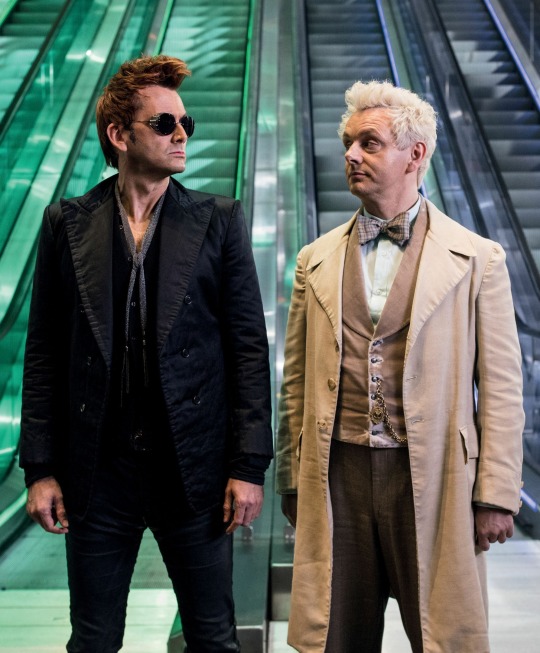
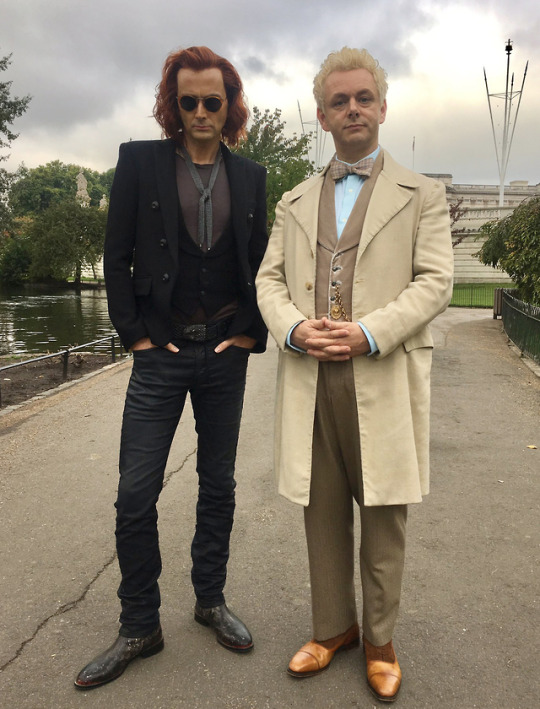
Excerpts from the SyFy Wire & Film School Rejects interviews with Claire Anderson, the Emmy-nominated costume designer for Good Omens:
[ Film School Rejects - by Ciara Wardlow] “I worked through it with gut reaction images. So, two guys. Two guys, kind of close, nearly in love, if you like,” she said. “I just went in and we had a really big, very open conversation about how you related to these people in the script and how we would make them real and plausible, but give them a fantasy element. Give them something otherworldly.”
While Anderson says that she ultimately took this approach with more or less all of the characters, mixing period and modern elements to give characters somewhat timeless, yet also somewhat fantastical “out of time” looks, in the early discussion stages it was all about Aziraphale and Crowley. For one thing, Sheen and Tennant were already cast, which was a major help in determining their looks. It took some time to settle on the duo’s main, contemporary looks, but once these were locked in they played a significant role in determining everything else they wore.
[...] Aziraphale maintains a look with significant nods to the late Victorian era. Crowley too, although he manages to put an edgier twist on things than his angelic contemporary. “We re-appropriate bits of period stuff so that it echoes. [Aziraphale and Crowley] echo one another in their visual identity with pieces from their past—where they’ve touched each other in the past perhaps, or bumped into each other.” Regarding how Crowley manages to keep more of a modern, cool vibe, Anderson gives David Tennant’s performance the lion’s share of the credit. “He’s a very nice man, but he’s very sexy. He brought all of that swagger, that rock star, snake-hipped sexiness, and we built on that.”

[ SyFy Wire - by Jennifer Vineyard] GARDEN OF EDEN, 4004 B.C. - Anderson looked at everything from Pre-Raphaelite paintings to Al Pacino’s hippie clothes in Serpico to determine just the right flow for Aziraphale’s rough-hewn robe, which has gold embroidery on the shoulders and side. Aziraphale is also wearing a golden ring, which later becomes a signet ring stamped with wings in the Victorian era.

NOAH'S ARK, MESOPOTAMIA, 3004 B.C. - “As aged as I am, I wasn’t there,” Anderson says, laughing. “And there wasn’t any painting or documentation from this era. But what we do know is that tunics remained pretty simple, and the earlier shape would have served them well for many years.” Aziraphale’s robe becomes more streamlined, and he wears gold beads at the neck.

THE CRUCIFIXION, GOLGOTHA, 33 - By this time, both Aziraphale and Crawley — now Crowley — are wearing turbans and head wraps, which Anderson attributes to “a bit of vanity.” Plus the wrap helps Crowley conceal his snake-like eyes (it’s too soon for glasses). Aziraphale dons a soft leather coat over his tunic, while Crowley wears female attire of the region — an abaya.

ROME, 41 - Switching from tunics to togas was difficult, since togas contain 6 to 12 meters of fabric, which is a lot to carry around on camera. Anderson reduced the size by cutting the togas to fit for the character’s movements, and she gave each actor a thematic decorative pin to hold their togas together — Crowley a serpent and staff, Aziraphale a pair of wings (both courtesy of George Easton at Danegeld Historic Jewellery). Although history might argue that it’s too soon for sunglasses, Crowley starts to shield his eyes with a very small, eye-shaped lens. “It’s suggestive, rather than historically accurate,” Anderson says. And as a sign that Crowley is adapting to the humans around him, he also wears a silver laurel wreath.
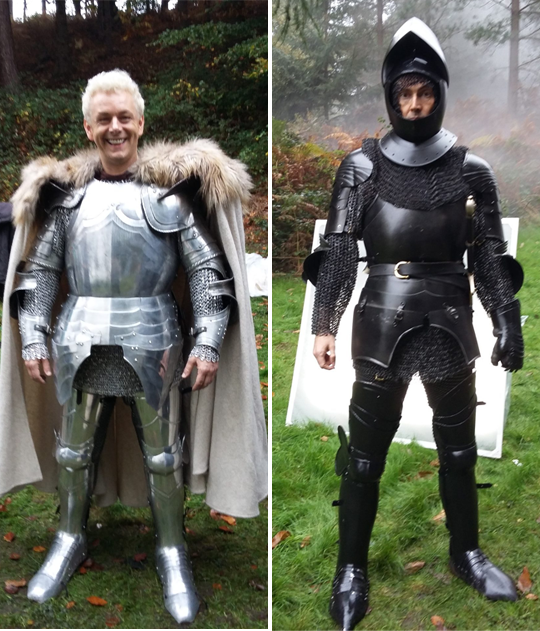
ARTHURIAN ENGLAND, THE KINGDOM OF WESSEX, 537 - Anderson sent character descriptions and visuals for Aziraphale and Crowley to armor specialist FBFX, which sent a van to London full of pieces that could work for angelic and demonic armor. Instead of focusing on historical accuracy, Anderson looked for shapes and fit that suggested an ethereal — or snakelike — quality, once the pieces had been painted black or silver. For Crowley, she found a helmet that had a smaller face that could suggest a snakehead, and for Aziraphale, shoulder pieces that were slightly wing-like. To add to the wing effect, Anderson added a white fur caplet to Aziraphale’s armor. “It was terribly grand, but not very practical,” she says. “And the poor guys, it was murderously uncomfortable to stand around in that armor.”

GLOBE THEATRE, LONDON, 1601 - Crowley and Aziraphale catch an early version of Hamlet, looking more period-appropriate than ever thanks to the Globe’s vast archive of costumes. Aziraphale’s wardrobe, which includes a neck ruff edged with gold thread, has a metallic look with a hint of iridescent blue, which opens up his color palette. Crowley, meanwhile, wears a cleaner neckline and leather on his doublet, as well as fabrics that provide sheen and luster to suggest his snaky origins.
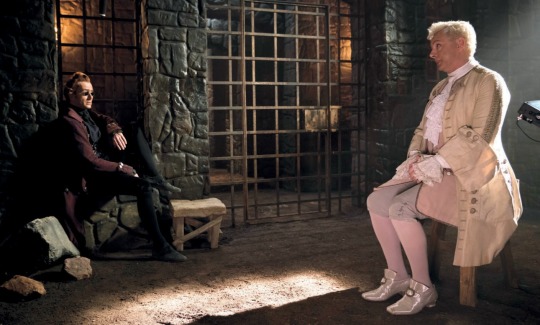
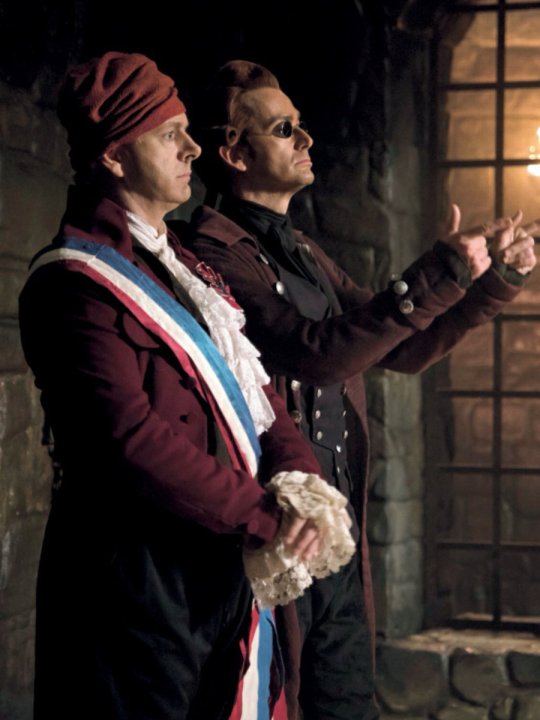
REVOLUTIONARY FRANCE, PARIS, 1793 - This is not a period to be dressed like an aristocrat, but Aziraphale couldn’t resist a lace collar, gold brocade and fitted jacket — which explains why he’s stuck in a prison cell (at least until Crowley intervenes). Crowley, more mindful of what revolutionaries would wear, dons a dark red jacket that’s almost as dark as his usual black. When Aziraphale miracle-changes his clothes, he wears the red cap of liberty. “It’s a soft beret that falls somewhere between a modern French beret and a pirate headdress,” Anderson notes.
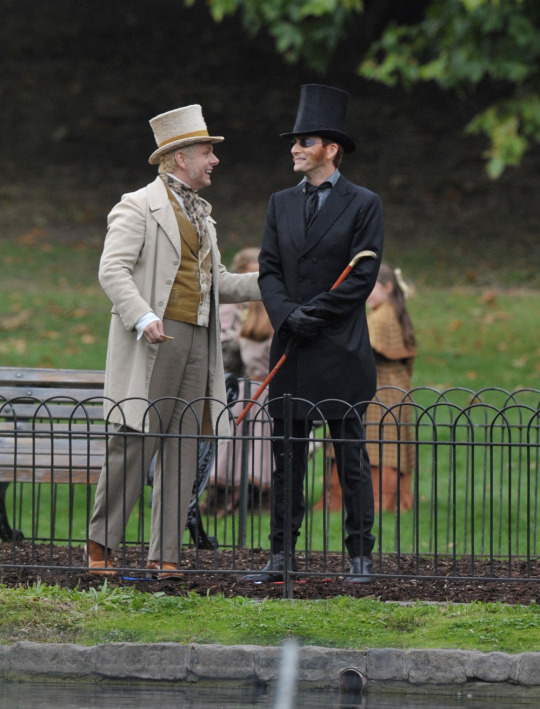
ST. JAMES' PARK, LONDON, 1862 - This is the time period with which Aziraphale gets most comfortable, fashion-wise, and settles into a Victorian look with tartan flair. Anderson also bestowed some heavenly nods to his angelic nature — a feathery velvet top hat, a stopwatch with angel’s wings on the chain, and the signet ring. Crowley, meanwhile, wears a pair of long, elegantly cut trousers that we will see again in the 1960s. “The trousers repeat, which is basically what fashion does anyway,” Anderson says. “And it’s what the story does. There are notes backward and forwards.”
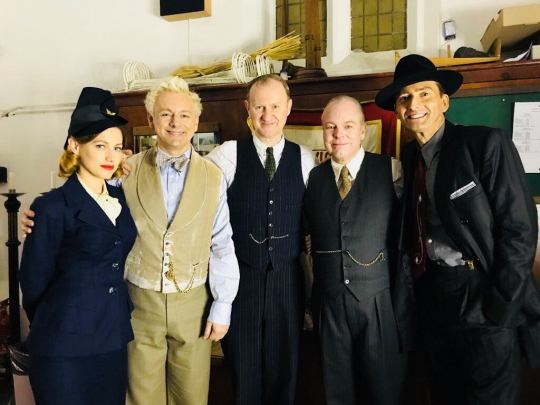
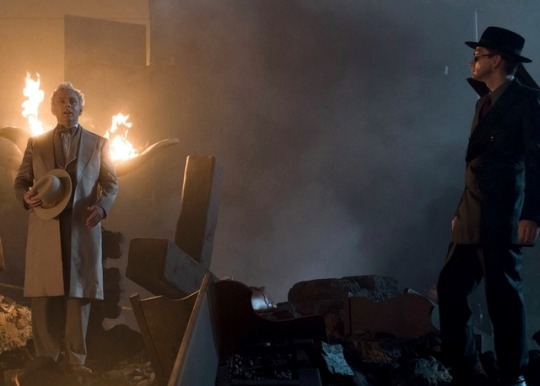
THE BLITZ, LONDON, 1941 - Aziraphale’s tartan necktie becomes a bow tie, and his penchant for wide lapels, a nod to his wings, continues, this time with a spear-point collar. Crowley, who comes to save Aziraphale once again, is dressed more formally, in a full double-breasted wool suit that must have been hard for David Tennant to wear in the South African heat. “The rest of the crew were in flip-flops and T-shirts, and David was in the suit, hat, and those big boots,” Anderson says, recalling the shoot. “He had to be very physically active in that scene, and yet David didn’t complain about the heat or anything. He’s amazing.”
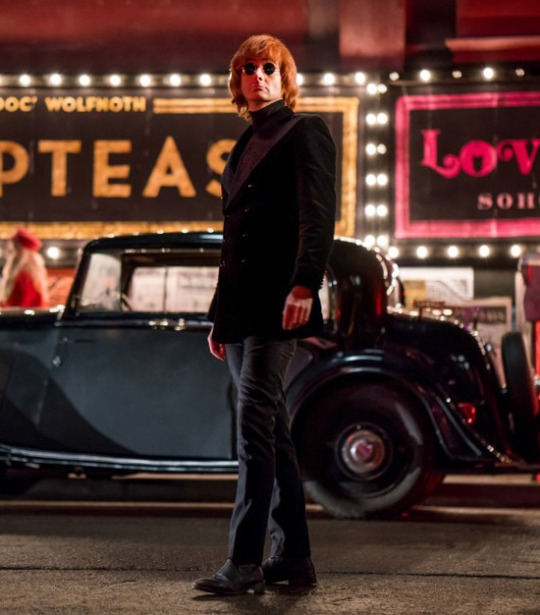

SOHO, LONDON, 1967 - Crowley, as noted, continues to wear his Victorian trousers, which are right up to date, and which he pairs with a black paisley velvet jacket with contrasting lapels. His sunglasses now have more of a John Lennon vibe. Aziraphale, perhaps inadvertently, is also looking stylish with his Victorian topcoat, spear-point collar, and cravat (modified from his scarf in Victorian England). “You can’t avoid being affected by changing trends,” Anderson says. “However bookish you are, you still notice other people. And you would have had Rolling Stones and Beatles fans wearing that kind of thing. That was our argument for Aziraphale wearing his Victorian topcoat all the way through, and Michael Sheen loved it. He said it inspired him. And the cravat rang in the changes and helped us with the passage of time, rather than always having him wear a bow tie.
#good omens#david tennant#michael sheen#ineffable husbands#crowley and aziraphale#claire anderson#long post#tennant tuesday#costume design#apologies for the length of this post#but it was all so darn interesting!#(guess I should have done part 1 and part 2?)#stuff i posted#they put so much thought into everything#I hope they win that emmy!#I'll probably reblog this with the links intact when I get home tonight#because it's killing me to not include the links to these two articles#p.s. I love the bit about david's snake-hipped sexiness#good omens costumes long post
18K notes
·
View notes
Text
Ranking Every SPN Season Premiere

15) 11.01 Out of the Darkness, Into the Fire. For an otherwise strong season, s11 sure started and ended in D tier. Not only is there a baffling amount of screen time spent on Cas’s weird and uninteresting rage spell, Crowley’s sexcapades, and too many one-episode characters, but the whole thing is sewn together with uneven flashbacks. The core concept itself is off: Darkness-as-rage-zombie-infection feels totally out of place in the rest of the season, and any personal fallout from 10.23 is mostly brushed aside. The only thing I like about 11.01 is Sam’s determination to find a cure and save everyone, and the mention of the cage.
14) 10.01 Black. Just because I do quite like demon!Dean’s apathy doesn’t mean it’s gripping television: he’s much better in 10.02 and 10.03, and most of 10.01 is spent on Crowley’s overdramatic griping. Cole is objectively very silly, but, look, I’m only flesh: Sam bloodied and in a sling and tied to a chair is good content, and rescues this one from D tier.
13) 15.01 Back and to the Future. Just like 11.01, 15.01 has to brush past Dean’s willingness to execute a family member in the previous episode, and it introduces a pretty weak zombies plot. However, it gets major points for Sam’s bullet wound visions, and is generally much better staged than 11.01.
12) 6.01 Exile on Main St. A genuinely interesting episode for Dean--both his domestic montage and being faced with Samuel are fresh takes on his relationship with family. Soulless is great, but isn’t quite hitting his stride; 6.01 lays groundwork but hasn’t yet built into s6′s greatest strengths.
11) 3.01 The Magnificent Seven. This one’s kinda campy, but there is some legitimately horrifying imagery, like the guy forced to drink drain cleaner. The deadly sins demons are underwhelming on the whole, but Ruby shows up in fine form, and Sam’s anger with Dean’s willingness to throw his life away establishes a great tone for s3.
10) 8.01 We Need to Talk About Kevin. Kevin is badass, Amelia is amazingly, unapologetically polarizing, Dean is raw, and I don’t really care about Benny. Sam is in a healthier spot right here than we’ll see him for a long, long time, which tees up his anti-recovery arc quite nicely.
9) 1.01 Pilot. It’s a solid introduction. Sam and Dean’s chemistry is potent and undeniable from the get-go. The way they work together so well, layered on top of so much conflict both spoken and unspoken, the things they want and the things they deny wanting--their first time interacting as adults out from under their father’s influence. It’s good!
8) 12.01 Keep Calm and Carry On. Look, I pretend to have complex opinions, but actually I am very, very simple: I just want to watch Sam tied to a chair and tortured. This is the best BMoL episode of the season by a long shot. On top of that, Mary’s introduction forces the uncomfortable and fascinating realization that she’s not going to fit quietly into Dean’s expectations. That final scene of Sam hurt and imprisoned without hope is gorgeous and memorable. 12.01 promised a lot for s12, and it’s a shame that most of it didn’t get followthrough.
7) 14.01 Stranger in a Strange Land. These next four are difficult to arrange, because they’re all so different. This episode has pretty much the only even vaguely interesting material AU!Michael gets all season. Far more importantly, Sam has the weight of the world on his shoulders, and it’s a great look. He has a beard, and he’s looking after Nick (!!), and he’s leading a group of hunters, and he declares that Hell itself better stand the fuck down. Sam for King of Hell 2k18. Iconic.
6) 2.01 In My Time of Dying. John’s deal, and his directive for Dean to save Sam or kill him, is a major turning point that colors everything for years. The human intimacy of the small-scale family drama, unfolding with no magic besides a terrible soul deal to rely upon, feels personal and real. Plus, Sam and Dean communicate via ouija board.
5) 5.01 Sympathy for the Devil. Meg and Zachariah are both in fine form. The apocalyptic set pieces are teed up and ready to be set loose. Sam jumps on the bandwagon of his own castigation, and it aches. Lucifer’s introduction is quiet, and chilling, and note-perfect.
4) 13.01 Lost and Found. It’s hard to significantly change the landscape of a 13-year-old show, and for the better, but 13.01 does just that. Jack is a breath of fresh air. His dynamics with Sam and Dean are complex and heartbreaking--he asks after his father, Sam locks himself in a cell with him. Dean’s blank absolutism mixes uneasily with Sam’s relentless determination and Jack’s innocence. It’s a wonderful new twist on an old formula.
3) 4.01 Lazarus Rising. Dean crawls out of his own grave, Sam’s with Ruby, Cas blows out windows and burns out eyes. 4.01 throws the mythological doors wide open with the introduction of angels, and ratchets the season up to an apocalyptic scale: it’s awesome.
2) 9.01 I Think I’m Gonna Like It Here. I am always and forever intrigued by Sam’s Mind Forests. Dean does something unforgivably horrible to Sam, and in doing so, opens the door to a fascinating arc, wherein his choices here and his treatment of Sam are deconstructed and then reconstructed and then deconstructed again. I’ll never get tired of season 9, by which I mean I’ll never get tired of the fallout from the BOLD choice that 9.01 made to put this conflict front and center.
1) 7.01 Meet the New Boss. If you thought I wasn’t going to put Hallucifer first, you must be extremely new here. Sam’s psychological undoing is chilling and deeply claustrophobic and possibly my favorite thing the show has ever done. On top of that, we have Godstiel’s terrifying purges, Sam and Dean summoning Death in someone’s living room, and even a taste of cosmic horror in LeviaCas. I would tell you how many times I’ve watched 7.01-7.02, but I’ve wholly lost count.
40 notes
·
View notes
Link
Interview with Claire Anderson, the costume designer for Good Omens!
GARDEN OF EDEN, 4004 B.C.
Anderson looked at everything from Pre-Raphaelite paintings to Al Pacino’s hippie clothes in Serpico to determine just the right flow for Aziraphale’s rough-hewn robe, which has gold embroidery on the shoulders and side. Aziraphale is also wearing a golden ring, which later becomes a signet ring stamped with wings in the Victorian era.
NOAH'S ARK, MESOPOTAMIA, 3004 B.C.
“As aged as I am, I wasn’t there,” Anderson says, laughing. “And there wasn’t any painting or documentation from this era. But what we do know is that tunics remained pretty simple, and the earlier shape would have served them well for many years.” Aziraphale’s robe becomes more streamlined, and he wears gold beads at the neck.
THE CRUCIFIXION, GOLGOTHA, 33
By this time, both Aziraphale and Crawley — now Crowley — are wearing turbans and head wraps, which Anderson attributes to “a bit of vanity.” Plus the wrap helps Crowley conceal his snake-like eyes (it’s too soon for glasses). Aziraphale dons a soft leather coat over his tunic, while Crowley wears female attire of the region — an abaya.
ROME, 41
Switching from tunics to togas was difficult, since togas contain 6 to 12 meters of fabric, which is a lot to carry around on camera. Anderson reduced the size by cutting the togas to fit for the character’s movements, and she gave each actor a thematic decorative pin to hold their togas together — Crowley a serpent and staff, Aziraphale a pair of wings (both courtesy of George Easton at Danegeld Historic Jewellery). Although history might argue that it’s too soon for sunglasses, Crowley starts to shield his eyes with a very small, eye-shaped lens. “It’s suggestive, rather than historically accurate,” Anderson says. And as a sign that Crowley is adapting to the humans around him, he also wears a silver laurel wreath.
ARTHURIAN ENGLAND, THE KINGDOM OF WESSEX, 537
Anderson sent character descriptions and visuals for Aziraphale and Crowley to armor specialist FBFX, which sent a van to London full of pieces that could work for angelic and demonic armor. Instead of focusing on historical accuracy, Anderson looked for shapes and fit that suggested an ethereal — or snakelike — quality, once the pieces had been painted black or silver. For Crowley, she found a helmet that had a smaller face that could suggest a snakehead, and for Aziraphale, shoulder pieces that were slightly wing-like. To add to the wing effect, Anderson added a white fur caplet to Aziraphale’s armor. “It was terribly grand, but not very practical,” she says. “And the poor guys, it was murderously uncomfortable to stand around in that armor.”
GLOBE THEATRE, LONDON, 1601
Crowley and Aziraphale catch an early version of Hamlet, looking more period-appropriate than ever thanks to the Globe’s vast archive of costumes. Aziraphale’s wardrobe, which includes a neck ruff edged with gold thread, has a metallic look with a hint of iridescent blue, which opens up his color palette. Crowley, meanwhile, wears a cleaner neckline and leather on his doublet, as well as fabrics that provide sheen and luster to suggest his snaky origins.
REVOLUTIONARY FRANCE, PARIS, 1793
This is not a period to be dressed like an aristocrat, but Aziraphale couldn’t resist a lace collar, gold brocade and fitted jacket — which explains why he’s stuck in a prison cell (at least until Crowley intervenes). Crowley, more mindful of what revolutionaries would wear, dons a dark red jacket that’s almost as dark as his usual black. When Aziraphale miracle-changes his clothes, he wears the red cap of liberty. “It’s a soft beret that falls somewhere between a modern French beret and a pirate headdress,” Anderson notes.
ST. JAMES' PARK, LONDON, 1862
This is the time period with which Aziraphale gets most comfortable, fashion-wise, and settles into a Victorian look with tartan flair. Anderson also bestowed some heavenly nods to his angelic nature — a feathery velvet top hat, a stopwatch with angel’s wings on the chain, and the signet ring. Crowley, meanwhile, wears a pair of long, elegantly cut trousers that we will see again in the 1960s. “The trousers repeat, which is basically what fashion does anyway,” Anderson says. “And it’s what the story does. There are notes backward and forwards.”
THE BLITZ, LONDON, 1941
Aziraphale’s tartan necktie becomes a bow tie, and his penchant for wide lapels, a nod to his wings, continues, this time with a spear-point collar. Crowley, who comes to save Aziraphale once again, is dressed more formally, in a full double-breasted wool suit that must have been hard for David Tennant to wear in the South African heat. “The rest of the crew were in flip-flops and T-shirts, and David was in the suit, hat, and those big boots,” Anderson says, recalling the shoot. “He had to be very physically active in that scene, and yet David didn’t complain about the heat or anything. He’s amazing.”
SOHO, LONDON, 1967
Crowley, as noted, continues to wear his Victorian trousers, which are right up to date, and which he pairs with a black paisley velvet jacket with contrasting lapels. His sunglasses now have more of a John Lennon vibe. Aziraphale, perhaps inadvertently, is also looking stylish with his Victorian topcoat, spear-point collar, and cravat (modified from his scarf in Victorian England). “You can’t avoid being affected by changing trends,” Anderson says. “However bookish you are, you still notice other people. And you would have had Rolling Stones and Beatles fans wearing that kind of thing. That was our argument for Aziraphale wearing his Victorian topcoat all the way through, and Michael Sheen loved it. He said it inspired him. And the cravat rang in the changes and helped us with the passage of time, rather than always having him wear a bow tie.”
#good omens#claire anderson#crowley#aziraphale#bts#costumes#oooooh#great article!#hey emmy jury just hand over that emmy will you? :)#thanks to sofacrawler for sending me the article :)
4K notes
·
View notes
Text
Sewing Your Own Face Mask (Or Wearing A Cloth Mask)
I’m gonna use this post to consolidate what I know about cloth face masks (making or wearing) because I am making myself crazy looking at different proposals and arguments and research. Under a cut so I can keep the post up-to-date without spreading misinfo.
Question: what’s the point of wearing a mask?
Masks of any kind do two things: prevent the wearer from inhaling germs, and prevent the wearer from exhaling germs.
Healthcare workers need masks that will prevent them from getting sick while they treat the sick: that’s why they’ve been desperate to collect N95 masks and face shields. If you’re not a healthcare worker, isolation and social distancing are better ways to avoid being exposed to germs than masking in public. Of course, not everybody can isolate right now -- people still gotta work, gotta buy groceries, gotta use public transit, etc. -- so going out in a mask is a decent compromise.
On the other hand, if you know or strongly suspect you’ve been exposed, wearing a mask can help you avoid infecting others. (This is how masking became a norm in Asian countries long before the coronavirus pandemic.) Again, carriers really shouldn’t be venturing out of isolation at all, but if you can’t avoid it, masking up can minimize the danger you pose to others.
As of 4/3, the Centers for Disease Control recommends that everyone wear a mask when they leave the house.
Update 6/1: As states “re-open,” requirements for face coverings in public may be dropped, but that doesn’t mean you have to stop wearing one. Especially if you’re attending a protest (crowds, lots of chanting/yelling), a mask can still keep you safe.
Question: how well do cloth masks work?
The evidence on this is pretty meh. The US Centers for Disease Control has said, “Any mask is better than no mask,” but studies have shown that cloth masks are strictly inferior to single-use medical masks when it comes to preventing the wearer from getting sick. Some reasons why:
Cloth masks are often made from materials that don’t trap tiny particles as effectively.This video explains how single-use masks work, and why woven material doesn’t work as well as the non-woven polymers that are normally used for medical masks.
Cloth masks absorb and retain moisture more than single-use masks, which reduces their efficacy over time. A study from India found that cloth masks and single-use masks both lose efficacy after two continuous hours, and another study in Vietnam found a single cloth mask worn throughout an eight-hour shift actually performed worse than single-use masks, and possibly even worse than no mask at all.
Cloth masks, depending on their design, may not fit snugly or smoothly, resulting in gaps that permit unfiltered air through. A recent study from Northeastern University in Boston found that pulling a nylon stocking over your mask-- not your whole head, we’re not robbing banks -- could significantly improve the effectiveness of any cloth mask, and even single-use surgical masks, by keeping everything snug.
A wonky mask might also cause you to touch your face more trying to adjust it, resulting in contamination.
Wearers may not be cleaning cloth masks effectively between uses, or may be cross-contaminating their hands when removing a used mask. See “How do I wear a cloth mask?” below.
So a cloth mask is a last resort when isolation isn’t an option and single-use masks aren’t available. As of 6/1, the US is still facing shortages of single-us PPE thanks to mismanagement by the Trump administration, and as states “re-open” the demand for masks will start to increase again.
Question: If cloth masks aren’t effective, why bother with them?
Some healthcare facilities have asked for donations of cloth masks in order to stretch their supply of single-use masks because, as stated above, we’re running out of supplies. Some other orgs (from nursing homes to animal shelters to police forces) have been asking for mask donations to conserve single-use masks for healthcare workers. For most people going out in our daily lives, a reusable cloth mask is more cost-effective than running through boxes of disposables, especially if we’re also doing what we can to avoid high-risk acitivies.
Question: What’s the best material to make a mask out of?
Research by Davies et al (2013) compared several different materials for DIY masking. Two factors are in play: how well does the material trap germ-sized particles, and how well can the wearer breath while wearing it? For example, vacuum bags are great for filtering tiny particles, but turned out to be uncomfortable and difficult to breath through, while woven silk was very breathable but a poor filter. (Some 3D printed masks that are currently circulating could give you fatal CO2 poisoning.)
The Davies papers’ recommendations were cotton knits (like a medium-weight t-shirt) or tightly woven cotton cloth (like a high thread-count pillowcase). More layers isn’t necessarily better, but most patterns in circulation use at least two. Some also incorporate a filter of some kind, either removable or sewn into the mask.
Knit fabric is tricky to sew, especially if you’re a beginner, but the trade-off is that a mask made with knit can achieve a snugger fit. Woven cloth is easier to work with, but the resulting mask may require more tailoring to avoid gaps. If you have a choice, use plain, light-colored fabrics so it’s easier to see stains or wet spots. (Also, frankly, a mask sanitized with bleach regularly won’t retain color for long.) Some hospitals are recommending using two fabric colors if you can, to ensure you can tell the “inside” and “outside” apart easily, but if you don’t have that much fabric laying around, use what you got.
To secure the mask, narrow (1/8 - 1/2 inch) elastic bands are common, but these can pull hair/rub skin. Woven elastic in this size is also getting hard to source, and may contain latex, which is an allergy risk. Consider instead making ties from bias tape or twill tape; narrow strips of sewn fabric; a clean shoelace; or narrow grosgrain ribbon (the kind with ridges).
Some mask designs include a pocket for inserting a separate filter, which improves their protective power. Good ideas for a filter:
Quilt batting or interfacing (Fusible interfacing may help make knits more workable, at the cost of their stretch.)
Extra layers of cloth
shop towels made from microfiber or “hydro-knit” material
Bad ideas for filters include vaccuum bags (not breathable, may contain fiberglass) and cut-up N95 masks (why???). And if you’re making masks primarily for personal use on short trips out, you probably don’t need a filter anyway, though Mueller and Fernandez (2020) found that cotton masks with a filter + a nylon stocking over the top actually approached the protective power of a single-use mask.
Question: What pattern should I use?
If you’re making masks for donation, use whatever pattern is requested. If you’re making them for personal use, or for donation to an org that hasn’t given any guidance, here are some ideas:
New: The Clover Mask is a hybrid of several of the designs below, designed by the MakeMasks.Org Slack. Intermediate difficulty.
Erin’s Mask, based on a design developed by Dr. Chen Xiaoting of Taiwan. Erin tweaked the pattern and converted it to US measurements for those of us allergic to metric. This mask has a pocket for a filter and can be made with either elastic or a fabric tie to secure. Intermediate difficulty.
Cynthia’s Mask does not have a filter pocket and uses twill tape or ribbon for tie-backs. Probably the easiest on the list.
John Hopkins Medicine has also produced a mask pattern pretty much the same as Cynthia’s. So has Kaiser Permanente, which also made a helpful video if you’re not used to making pleats.
The Aries 2.0 Mask is being produced en masse by volunteers in St. Louis, which is where I’m based. It’s more complicated than Cynthia’s mask, and has a filter pocket like Erin’s mask, using curved pieces instead of pleats to achieve a good fit. Intermediate difficulty.
Some additional options, which have been less popular than the above:
The Turban Project Mask has been promoted by Deaconess Medical Center in Evansville, Indiana. It uses elastic and has no filter pocket. Just as easy as Cynthia’s mask, but the ear loop design may be less comfortable and some people have reported shortages of elastic.
The A.B. Mask is designed to be worn over an N95 mask, to extend its lifespan, or by itself. It uses cloth ties. It’s the most complex pattern to sew on this list, with darts and seam binding, but was designed by a nurse.
The Fu Mask from Freesewing uses curved pieces like the Aries mask, but has no filter pocket, which makes me a little more leery of the big center seam.
The Olson Mask has a filter pocket and uses regular hair ties for fasteners.
If you don’t sew at all, this mask can be folded from one sheet of cut cloth. A silky scarf might not be optimal material (see above re: material types) but a cotton bandana or a “fat quarter” of quilting cotton is almost the same size. If you’re using cut fabric, you could just tape or whipstitch the raw edges so it’ll survive the washing machine.
There are a ton of Facebook groups, Discords, etc. with suggestions on how to tweak these masks for best fit or greater comfort. One common hack is putting a length of pip cleaner or floral wire in the upper seam, to help the mask conform around the bridge of your nose. Be cautious when washing a mask with a built-in wire, because it might rust; the Aries 2.0 mask has a sleeve so the wire can be removed for cleaning.
Question: how should I wear/clean a cloth mask?
Depending on the mask, you might secure the mask behind your head or over your ears, either with elastic bands or cloth ties. Make sure you’re breathing primarily though the mask, and not around the sides, even when you turn your head or talk. (This might require some tweaking of your pattern.) This NYT piece has illustrations of how the mask should sit -- over your nose and under your chin, snug to your cheeks on both sides. If you can’t click through, @theexoticvet has posted the images here.
(Note: an N95 mask can’t make a tight seal over facial hair, but a cloth mask doesn’t seal even on a smooth face. So don’t fret about your beard making your cloth mask useless -- just make sure it’s pulled snug all the way around.)
Studies suggest a fabric mask is useful for two hours, max, or until your breath makes it noticeably damp. When you remove the mask, grasp it by the ties, loops or edges. Don’t touch the part that covers your nose or mouth, because that’s where germs have accumulated. If there’s a removable filter inside, wash your hands thoroughly after removing it, and then wash the mask.
Research shows the novel coronavirus can persist ~24 hours on a cardboard surface, but not necessarily how long it survives on/in cloth. Also, leaving a potentially contaminated mask laying around is probably not a good idea. So, to clean your mask:
Hand-wash with hot water and soap, at a minimum.
Boiling the mask for ~10 minutes should kill just about anything, but don’t just drop it in the pot and forget it -- you should keep stirring/agitating the water so it thoroughly penetrates all layers.
Add 1 T (15 ml) of bleach to 1 gallon (3.8 L) of cold water and soak your mask for 15-30 minutes. Then rinse thoroughly with hot water. Over-bleaching will degrade the fabric and make the mask less effective.
If you have access to a washing machine and/or a tumble dryer with a “sanitize” setting, use that. Otherwise use the hottest settings each one has.
If you have to air-dry your mask, make sure it’s completely dry before you use it again.
Question: How can I make masks to donate?
As of 6/1, mask donations are ramping down as the supply chain for both conventional PPE and reusable masks has stabilized. Most people and orgs can now buy reusable masks if they want them. On the other hand, some people can’t afford to buy a mask, so homeless shelters, food pantries and crisis nurseries may still be taking donations. Activist groups planning protests may also be looking for masks to distribute at their events.
Donations are being coordinated on a Make Masks Slack channel, at #MasksNOW, or at RosieSews.org. You can also text “masks” to ResistBot (50409) to find out how to help get PPE to healthcare workers who need it. Also try a Facebook search for “Million Mask Mayday” + your state, as the original Million Mask Mayday site was overwhelmed.
Check one of these spots or contact a local org BEFORE you sew a bunch of stuff, to ensure you’re matching their needs. Just dropping off a bunch of masks off randomly to a group that doesn’t even need them isn’t helping anybody.
If you initiate contact with a facility or org, ask them a) are they taking donations, and b) do they have specific needs regarding size, materials, or construction.
Also ask about whether the masks need to be sanitized before donation (use one of the methods above) and how donations should be delivered in light of social distancing recommendations.
257 notes
·
View notes
Text
Saturday 8 August 1835
8 ¼
12 ¾
No kiss. Very fine morning - very kind note from Lady Stuart de R- more thanks for the table - hopes I shall not leave London till after Wednesday that she may see me again - breakfast at 9 ½ - considering with A- and till 12 ¼ wrote copy of note to Mr Johnson about the schools - A- went to Mr Dumergue again at 11 for about ½ hour - left her to go at 1 to dine with Mrs Plowes (glass coach and laquais de place) and drove to Whitehall - there at 1 - sat about ¾ hour with Lady Stuart and Lady V- The former in a stew about Thrupp in Oxford Street her coach maker to whom it seems she owes seven hundred pounds carriage hire and accumulations Thrupp wanted paying and Lord S- bound himself with his mother for her paying him by instalments of fifty six pounds odd per annum the bill drawn by Mr Stuart (Charles I suppose) came this morning or rather notice of its being due the man could not wait must have money no draft would be take Lady S- did not understand it we had Thrupp’s impertinence talked over Lady S- has Lord Stuart’s chariot will have nothing more to do with Thrupp in which I joined till I saw into the thing (saw the paper left by Thrupp’s banker’s clerk or messenger) and advised
SH:7/ML/E/18/0077
Lady S- merely to send the notice of the bill being due to her own banker and desire him to honour that is pay it Lady S- glad I had happened to be there to tell her what to do Vere said nothing had I offered the money it would have been taken but of course I knew better Lady S- fears my lord is laying out a great deal at Highcliffe and wonders where it is to come from how they are all running to ruin let it be a lesson to me. From Whitehall drove to the National school, and left my note to the ‘revered Mr Johnson, central National school, Westminster’ - then to Colnaghi’s - stopt at the door to say I would look at the books on perspective - should be in town till Monday - to see the British museum now closed to strangers (open to students) should write to the secretary ‘the revered Josiah Forshall Secretary to the British museum’ - then drove to 34 Hertford street - lady Gordon not at home - sent up my card - admitted to Georgiana - Lady G- very ill in bed with so bad a headache could not see her - Alice in Herefordshire - lady S- and Georgiana going to Scotland (per steam to Edinburgh) passage take for Wednesday - staid about 5 minutes and then to Lady Mexboroughs’ - very kind and glad to see me - shewed me the company rooms above and below - went down to luncheon and had excellent prime-cut exprès pour moi - asked me very kindly to visit her at Methlay - hoped I would go - Lady Sarah and Arthur Savile with us at luncheon - gave lady M- Thorpe’s address 28 or 38 Bedford street Covent garden, and said if Lady Hardwicke really wished to sell any of her books perhaps he would give as much for them as anybody would - then drove to 16 Orchard street - Miss Hall not in London - in the North - wrote in pencil at the corner of my card ‘Saturday 8 August 1835’ - then to the Pantheon, new bazaar, in Oxford street just to take a peep at and inquire about the sketch we admired the other day - yes! really by the Turner T- R.A. price 4 guineas done when he was very young, and given to his friend Dr. Monroe - would not now give lesson under any possible circumstances - would not put pencil to paper under 20 guineas - Dr. M- had a collection of sketches by 1st rate artists - the collection was sold - then some difficulty in finding Taylor the publisher 6 Barnard’s Inn, Holborn - a long but tidy narrow passage at the end of which T-‘s house - sometime there - saw only his clerk - bought Banks on a millwheels etc etc and got 10 pc taken off little thought A- had been there before and bought duplicates (full price) of the perspective I got for her and a little 2/. pamphlet on repairing roads - home at 4 ½ - A- has locked up my journal - beside myself at the disappointment - asleep - dressed - at Lady Stuart’s to dinner at 7 10 - only herself and Lady VC- very kind and glad to see me - dinner at 7 ½ - Miss Hyrioth came in the evening - Charlotte S- spending the day in Grosvenor square at Lady Cunnings’ - Lady S- de R- and Louisa gone to Hatfield - Lady S- begged me to write to Lady Harriet - V- can always receive anything free thro’ Mr. Cameron’s cousin by marriage the ‘Honourable Fox Maule, Home office, London’ - V- goes on Wednesday - to spend 2 nights at Lady Northlands’ and .:. be 3 days on the road 57 miles to ‘Brafield House Olney Bucks’ - I may send what I like (in moderation i.e. any moderate quantity sheets of paper) thro’ Mr. FM. so asked V- to write to me often and said I would scribble her something or other in return, busy as I was - she said I must have a hoard somewhere, or coal or something must yield a great deal or how could I build Inns and talk of a house in London etc - hoped I should not ruin myself - I hope not said I - but, if I do, my little friend Miss W- must help me out - come to me said V- I will keep you - I said A- had a very good fortune - but I should take care -had no thought of an house in London perhaps for these 10 years to come - V- said she knew not how it was, she always associated the idea of me with her travels - it seemed as if I had been with her everywhere I had given away her place - I laughed and said it was she who had taken 3 (Donald and 2 children) into mine - she said she had seen no antiquities in Rome as she ought to have done for want of me - She said she was jealous it was joke but somehow she was for her very affectionate I almost fancied she really liked me in some degree as great as her small quantity of warm feeling would permit. Seemed pleased at my promise to go and see her in Scotland and perhaps in Bucks - she said she should be delighted to come to Shibden sometime or other - Miss Hyrioth had walked - I set her down in passing and got home at 11 - A- had returned at 9 ½ and had had tea - Mr Thomas Edwards very ill - Mrs Plowes with him - A- had dined with the children and then gone to Mr TE-’s and sat about a couple of hours with Mrs P- no hope of Mr John E-‘s recovery - had made his will - say up talking about an hour - very fine day - F68° at 12 ¾ tonight - V- accidentally mentioned that her Perrelet-watch did not go very well - not at all well till Jefferson in Bruton street (the best in London) watchmaker or cleaner one or other had it to clean - she said it had never been visitée at all - V- owned she had bought it in a great hurry - P- had only a week to get it ready in and had a very small stock of watches by him at the time.
1 note
·
View note
Text
Beer Events 9.25
Events
Pacific Ocean discovered (1513)
1st American newspaper published (1690)
Brayton Weatherbee patented a Machine for Picking and Separating Hops (1894)
William Helmer patented a Design for a Drinking Glass (1906)
Joseph Strunce patented a Beer Pipe Cleaner (1906)
Senator Morris Sheppard was so convinced that Prohibition would be permanent that in a speech today he said "there is as much chance of repealing the 18th Amendment as there is for a hummingbird to fly to the planet Mars with the Washington Monument tied to its tail. (1930)
John Schilling patented a Crown Cap Puller (1934)
American Can Co. trademarked a flat-top beer can called "keglined" (1934)
Myron Hood patented a Gas Mixing Device for Draught Beer Dispensing (1951)
Owens Illinois patented a Composite Container Article (1973)
Summit Brewing delivered their 1st keg (St. Paul, Minnesota; 1986)
Young’s Ram Brewery closed (England; 2006)
James Muth patented a Keg Stacking Device (2008)
Rehrig Pacific patented a Beer Keg Valve (2013)
Breweries Opened
Boulder Beer Co. (Colorado; 1979)
Leavenworth Brewery (Washington; 1992)
North Peak Brewing (Michigan; 1997)
Kishiwada Brewery (Japan; 1999)
Faction Brewing (California; 2013)
0 notes
Photo

“Desperadoes at Liberty After Slugging Turnkey At St. Catharines Jail,” Toronto Globe. January 8, 1930. Page 01. ---- Two Convicted Hold-Up Men Stun Official and Dive to Freedom Through Windows - Companion Caught Before He Gets Away ---- ROADS WATCHED FOR FUGITIVES ---- (Special Despatch to The Globe.) St. Catharines, Jan. 7. - John Bradt [TOP] and James Smith [BOTTOM] of Hamilton, two convicted hold-up men and allegedly dangerous criminals, escaped from St. Catharines Jail this evening after they had knocked down Turnkey William Warner in the prisoner’s corridor. Late tonight they were still at large.
When Warner entered the prisoners’ corridor about 5 o’clock, presumably for the purpose of calling the prisoners to supper, he left the corridor gate open. Quick to notice the omission, either Bradt or Smith dealt the stunning blow which placed the middle-aged turnkey helpless on the floor, and dashed for the near-by front exit of the jail.
William Bradt, aged 19, brother of the escaped John Bradt, accompanied the other two on their dash for the front exit, but Turnkey Warner, who had arisen dazedly from the floor and staggered after the running trio, managed to collar William before he got clear of the premises. John Bradt leaped to the outdoors through one open window of the jail office, and Smith took a dive through a window of an adjoining room. Nothing has been seen of them since, although every highway is being patrolled by Provincial and other police.
Governor John Dundas, in charge of the jail, refused to make any statement tonight regarding the jail-break.
All three men participating in the jail-break have been convicted on various charges in Hamilton, St. Catharines and Thorold police courts, sentences running concurrently. John Bradt was sentenced to two and a half years, his brother William to eighteen months in the reformatory, and Smith to two years less a day in reformatory. They would have dispersed to the penitentiary and reformatory tomorrow, and probably knew of that plan. The three men were found guilty of extensive auto thefts in Hamilton, armed robbery of a service station in Granham Township, and breaking into the Steadman jewelry store, Thorold. The loot from this shop was found when the arrests were made at Hamilton. The police regard the escaped men as dangerous, and every effort is being made to recapture them.
Second Escape Hamilton, Jan. 7. - Local police were watching all the highway entrances here tonight in the hops of intercepting James Smith and John Bradt, two youths of this city, reported to have escaped from the county jail at St. Catharines this afternoon. They were wearing khaki shirts and trousers, and no coats or hats.
Smith and Bradt were convicted here a few days ago of stealing automobiles, and were sentenced to prison terms. They were taken to St. Catharines for trial on a charge of breaking into a robbing a jewelry store at Thorodl, and were in the county jail. Some of the loot was recovered here.
Last September Bradt and his brother escaped from the city jail in St. Catharines shortly after they were arrested on a charge of stealing an automobile.
[AL: Bradt and Smith were recaptured the next day, and given additional years on their sentence for the escape on the 9th of January. Both men had been sentenced to charges of theft and housebreaking. Bradt went to the penitentiary immediately, whereas Smith went to the reformatory and was sent to Kingston Penitentiary in April 1931. Bradt was convict #1547 and worked first as a cleaner then in the mail bags. He complained of the hard work, bad dust, outdated machinery, and tough quotas - also that the officers got smoke breaks but the inmates did not (unlike at the Guelph Reformatory.) Bradt was reported and lost ten days of his remission for having a punk lighter, and he was caught frequently with cigarettes at work and in his cell. He was frustrated that he could not see his brother, William, who came to the penitentiary in September 1930, as neither man was close to their families and had no living parents. Eventually in mid-1932 they were allowed one visit by the acting Warden. He was in the Prison of Isolation, the overcrowded and grotesque old punishment unit, where the food was bad and he had to go in a bucket instead of a toilet. Bradt joined the riot in October 1932, supporting all its demands. He continued to support the demands of the protesters until at least mid-1934, based on his signature being on some manifestos. He was released in May 1935. Smith was convict #2162 and worked in the Stone Shed, and then was send to finish building the Female Prison. He was also in the Prison of Isolation, and despised conditions there - this appears to be the main grievance that led to him supporting the riot in 1932. Smith was released in June 1933.]
#st. catharines#hamilton#housebreaking#break and enter#escape from jail#jailbreakers#jail break#theft#desperadoes#desperate bandits#county jail#sentenced to the penitentiary#kingston penitentiary#sentenced to prison#guelph reformatory#great depression in canada#crime and punishment in canada#history of crime and punishment in canada
1 note
·
View note
Text
Famous American Artist: Andy Warhol



Andy Warhol - American, 1928-1987. Andy Warhol, one of the most notable artists of the 20th century, turned his fascination with pop art and advertising into iconic works of art. Warhol had a successful career as an illustrator in New York City before standing out as an artist with his paintings and celebrity portraits "32 Campbell's Soup Cans." He worked in a variety of media, including screen printing, sculpture, photography, and film. Warhol opened a studio in New York called The Factory, where everyone from intellectuals and activists to celebrities and drag queens gathered. He laid the groundwork for artists that followed like Keith Haring and Jeff Koons. Bidsquare presents Andy Warhol Arts for sale. Bid on famous works of art by Andy Warhol available at auction.
When he graduated from college with his Bachelor of Fine Arts in 1949, Warhol moved to New York City to pursue a career as a commercial artist. It was also at this time that he dropped the "a" at the end of his last name to become Andy Warhol. He landed a job at Glamor magazine in September and became one of the most successful commercial artists of the 1950s. He won frequent awards for his singularly whimsical style, using his own technique of erased lines and rubber stamps to create his drawings.
In the late 1950s, Warhol began to pay more attention to painting and, in 1961, he debuted the concept of "pop art," paintings that focused on mass-produced commercial products. In 1962, he exhibited Campbell's now iconic soup can paintings. These small canvases of everyday consumer products created quite a stir in the art world, bringing Warhol and pop art to the national spotlight for the first time. We can explore more about Andy Warhol art in Bidsquare.
British artist Richard Hamilton described pop art as "popular, transitory, expendable, inexpensive, mass-produced, young, witty, sexy, sophisticated, glamorous, big business." As Warhol himself put it: "Once you 'have' pop, you can't ever see a sign the same way again. And once you think of pop, you'll never see America the same way again." Andy Warhol pop art featured Coca-Cola bottles, vacuum cleaners, and hamburgers.
In 1968, however, Warhol's prosperous career almost ended. Valerie Solanas, an aspiring writer and radical feminist, shot him on June 3. Warhol was seriously injured in this attack. Solanas had appeared in one of Warhol's films and she was reportedly upset with him for her refusal to use a script that she had written. After the shooting, Solanas was arrested and later pleaded guilty to the crime. Warhol spent weeks in a New York hospital recovering from his injuries and underwent several subsequent surgeries. As a result of the injuries he sustained, he had to wear a surgical corset for the rest of his life.
In the 1970s, Warhol continued to explore other forms of media. He published books like The Philosophy of Andy Warhol (From A to B and Back Again) and Exposures. Warhol also experimented extensively with video art, producing more than 60 films during his career. Some of his most famous films include Sleep, which shows the poet John Giorno sleeping for six hours, and Eat, which shows a man eating a mushroom for 45 minutes.Warhol also worked in sculpture and photography, and in the 1980s, he moved on to television, hosting Andy Warhol Television and Andy Warhol's Fifteen Minutes on MTV.
In his later life, Warhol suffered from chronic problems with his gallbladder. On February 20, 1987, he was admitted to New York Hospital, where his gallbladder was successfully removed and he appeared to be on the mend. However, days later he suffered complications that led to sudden cardiac arrest and passed away on February 22, 1987, at the age of 58. Thousands of people attended a tribute to the artist at St. Patrick's Cathedral in New York City.
1 note
·
View note